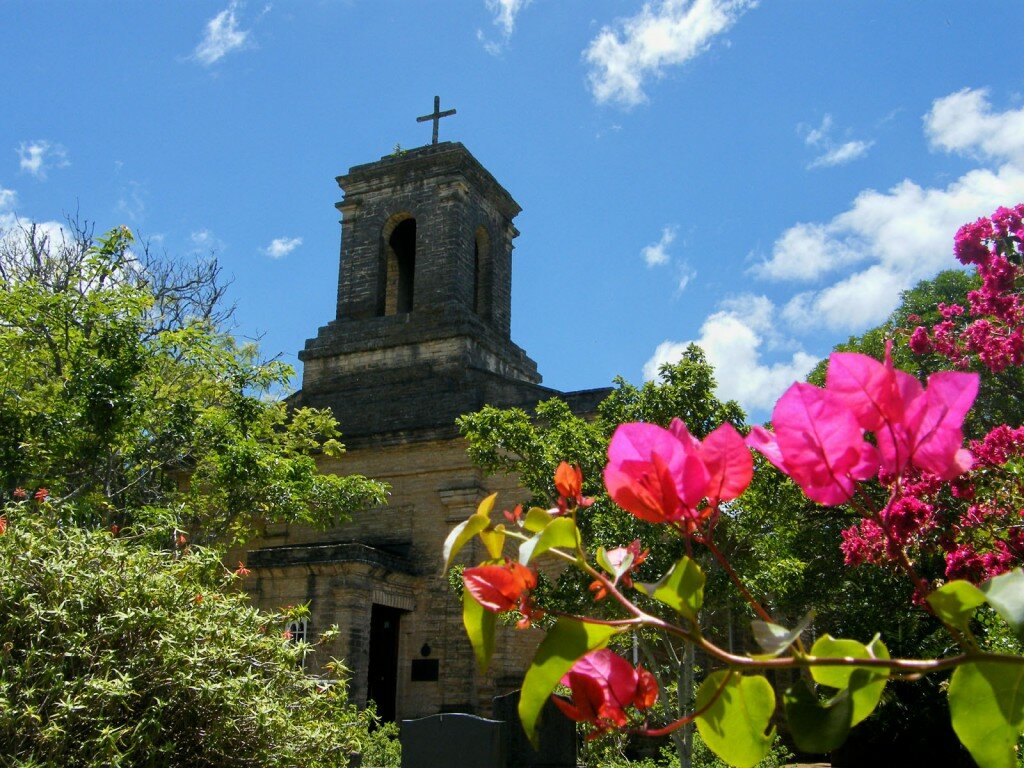Oldest unaltered Anglican church in South Africa. A sanctuary in the Frontier Wars of 1834, 1846 and 1851 for hundreds of Settlers. 1st service held on the 1st January 1838. Look for the “church mouse” on the west wall!! 
St John’s Church at Bathurst was, designed by Major Charles Cornwallis MICHELL of the ROYAL ENGINEERS in 1829.
The original site for the Bathurst Church was fixed on the north side of the town, at the top of the central hill. But after the growth of the town was halted when the magistracy was moved to Grahamstown in 1822, the majority of the houses that had then been built were on the south of the hill. When, in 1810, the proposals for the erection of a church were quite far advanced, Governor Sir Lowry Cole visited Bathurst and granted a new site for the church in a position dominating the existing town, on the brow of the hill. It would seem that the church was at this time already designed, and that the original design was fairly strictly adhered to when the church was built on the new site. Michell, now Surveyor-General and Government Architect in Cape Town – one of the most versatile of the architect-engineers to serve in that capacity at the Cape.
Funds for the building were obtained partly by the sale of 104 £5 (R10) shares in the church, interest to be paid from the pew rents and offertories! The contract for the stonework was signed on 21 December 1831, with the settler Samuel BRADSHAW. He undertook to build the walls and the tower for £390 (R780). In March, 1832, the first sod was turned and in May the foundation stone was laid. BRADSHAW used stone from the Freestone Quarries and worked so well that the shell of the building was completed by the middle of 1833. The masonry was completed by May 1833, and tenders were then called for the carpenter’s work in the roof, that accepted being tor £156 (R312). In December 1833 the bell was hung in the tower. In October, 1834, tenders were invited for the roof. In the meanwhile the Rev. James Barrow succeeded the Rev. George Porter. Tenders for roofing the building with zinc sheeting were called for in November 1834.
The outbreak of the Sixth Xhosa War in December, 1834, stopped all work on the church. The Settlers on the outlying farms were instructed to go to Bathurst. The safest place there was the uncompleted church, so the women and children took refuge in it while the men mounted guard around it. On Christmas Day a large force of Xhosa attacked the church and the cattle kraals which had been hastily erected around it. But the settlers and the troops sent from Grahamstown resisted the attacks on that and the two succeeding days. Repeated attacks on the church by the Xhosa were beaten off until the inmates could be evacuated to Grahamstown by means of a convoy of ox wagons. Three weeks later the church was re-occupied as a military post at which punitive patrols were based. But the building continued to be attacked, a fierce struggle taking place there on 6 February. After that the attackers were gradually driven out of the district, and with the signing of a peace treaty on 17 September it was possible to reconsider the question of the completion of St John’s. Sauce
Learn why to choose Travel to Fair.